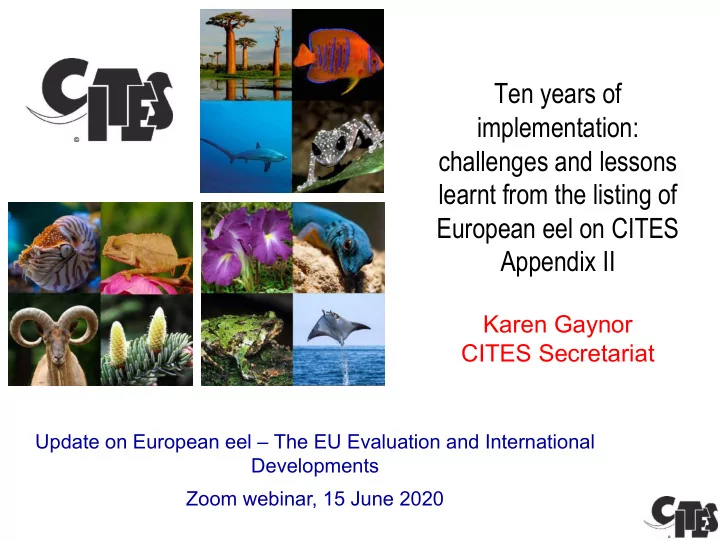

Ten years of implementation: challenges and lessons learnt from the listing of European eel on CITES Appendix II Karen Gaynor CITES Secretariat Update on European eel – The EU Evaluation and International Developments Zoom webinar, 15 June 2020
What is CITES? A multilateral agreement that operates through an intergovernmental process, Combines wildlife and trade rights and obligations in a legally binding instrument, achieving conservation and sustainable use objectives
3 What is CITES? • Agreed in 1973, in force since 1975 • >36,000 listed species, parts and derivatives • 183 Parties (members) to date
4 Misconceptions about CITES • CITES deals with all aspects of wildlife conservation – CITES deals only with international trade in certain species included in its Appendices • CITES aims to ban all wildlife trade – CITES aims to regulate international trade (for some species trade is highly restricted) • CITES regulates domestic trade – CITES can only address international trade
Misconceptions about CITES (2) 5 • The CITES Appendices are a listing of the world’s endangered species – The Appendices only list those species that are or may be affected by international trade • CITES imposes trade restrictions on developing countries and transition economies – Both producer and consumer countries have responsibility for conserving and managing resources – CITES creates the means for international co- operation
CITES-regulated trade must be 6 legal, sustainable, traceable Legal and sustainable trade can be beneficial for conservation of wild species, livelihoods, economies… …illegal and unsustainable trade can pose a serious risk to the species, people and business
CITES Appendices 7 Species subject to CITES regulation are divided amongst 3 Appendices I II III "Species" means any species, subspecies, or geographically separate population thereof
CITES Appendices: Scope 8 Appendix III Appendix I Appendix II Species Species for Species not threatened with which a necessarily extinction country is threatened with asking Parties extinction, but for to help with its which trade must protection be regulated to avoid their becoming threatened
CITES Appendices: 9 international commercial trade is… Appendix I Appendix III Appendix II …generally …permitted …permitted prohibited but but controlled controlled
10 Ø European eel is one of 16 species of anguillid eels, but it is the only one that is covered by CITES Ø European eel ( Anguilla anguilla ) was listed on Appendix II of CITES at CoP14 (June 2007) and the listing came into force 13 March 2009
Ø As an Appendix II species, commercial trade in European eel could continue subject to the following: 1. Legal ‘A Management Authority of the State of export is satisfied that the specimen was Acquisition not obtained in contravention of the laws of that State for the protection of Finding (LAF) fauna and flora.’ and 2. Non- ‘ A Scientific Authority of the State of export has advised that such export will not be Detriment detrimental to the survival of that species ‘ Finding (NDF) An NDF is a science-based risk assessment
Main direct exporters of eel 12 RST Quota 2020 Details Morocco Yes Yes 500t adult eel from aquaculture; 0t glass eels; 5.5t adult wild Tunisia Yes Yes 90t (>30cm long); 0t glass eel Turkey - Yes 100t live or dead; wild specimens Algeria Yes Yes 8t (to be published) Egypt _ -
Eel in the EU • CITES implemented through the EU Wildlife Trade Regulations, which are stricter than CITES • EU Member States unable to make an NDF for Anguilla anguilla , so in December 2010 a zero export quota was established and imports from non-EU range States into the EU were also suspended • This “ban” remains in place today • Council Regulation (EC) no 1100/2007 sets out measures for the recovery of European eels, including requirement for Member States (MS) to develop Eel Management Plans (EMPs) at the river basin level
Determining effectiveness of listing 14 Ø Difficult to assess Ø What metrics should be used? - legality, sustainability and traceability? Ø listing in place for a relatively short period (15 year eel generation time) Ø Difficult also to distinguish the effect of the listing from the effects of the EU trade ban – latter probably greater impact (but one dependent on the other)
Impacts of the CITES listing - Pros 15 Ø Raised awareness and profile of the species Ø Brought range of sectors together (including marine and f/w fisheries managers) Ø Political will to conserve and sustainably manage the species was mobilised
Impacts of the CITES listing - Cons 16 Ø Pushing trade onto other less well understood species of eel Ø Pushing trade underground – increase in illegal trade Ø Has shifted the focus on to harvest and subsequent trade as a driver of decline, but there are other wider considerations that are receiving less attention
Lessons learnt 17 Ø Listing not an achievement in its own right – implementation is critical (plus trade is only one of a series of threats) Ø Delayed listings (18 month preparation period) need to be used more constructively to drive change in support for management and (legal) trade practices Ø Listing a species can shift the trade to another related species (needs to be monitored) Ø The need for a coordinated approach between all stakeholders (including industry representatives)
CoP18 Decisions on eels aim to : Ø encourage greater collaboration between European eel range States, transit and destination States in the conservation and management of the species and in tackling the illegal trade; Ø encourage range States of non-CITES listed anguillid eels to improve the management of those species; Ø investigate levels of trade and emerging trends in trade patterns concerning anguillid eels, Ø look in more detail at a range of issues including NDFs, traceability, illegal trade, ranching and customs codes
19 CITES Secretariat Geneva www.cites.org
Recommend
More recommend